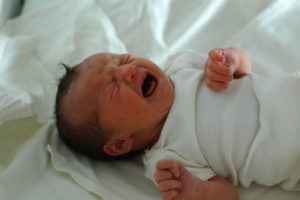You’ve probably heard the advice that it’s okay to let your baby cry while you do other things, that crying strengthens the lungs, or that if you respond immediately, the baby will become spoiled. Of course, sometimes we all need a good cry – we’re stressed and need some relief, but wouldn’t it be better if, when you cried, your partner came to comfort and soothe you instead of ignoring you? The same goes for the baby. As with many complex issues, there’s often a kernel of truth beneath layers of misconception. So, it’s worth understanding some physiological factors before claiming whether or not crying strengthens the lungs. 
Pulmonary Development
Lung development doesn’t end the day a baby is born. Although the lungs themselves aren’t muscles, it’s certainly true there are large muscles associated with the lungs (mainly the diaphragm and the intercostal muscles), and exercising these muscles does, in fact, improve lung function. However, that does not mean that crying strengthens the lungs or that babies who cry more will improve their lung function. There are determinants that will make all the difference, but it’s clear that crying or shouting is not one of them.
When to Let the Baby Cry?
There is a physiological basis for the argument that crying strengthens the lungs or that babies should be left to cry—in other words, that crying is beneficial for lung development. But this only happens during the transition from intrauterine to extrauterine life. It is absolutely crucial that babies cry as soon as they are born, because in the womb, their lungs are filled with amniotic fluid, and when they pass through the birth canal, they are squeezed.
The Importance of Crying at Birth
The lining of their alveoli is wet and sticks together like damp sheets of paper. Babies need to take their first good, deep breath (which is prompted by crying) to force the alveoli to open. If everything goes according to plan, the alveoli are coated with surfactant (a substance produced by the body that facilitates the exchange of respiratory gases in the lungs), which dramatically reduces surface tension and makes breathing possible.
Why Do Babies Cry?
The way communication occurs between a mother and her child is through crying. A baby doesn’t have the verbal skills to tell his or her mother what they need. So, the baby will cry to communicate. When a child feels a need, this triggers an automatic response where air fills the lungs, followed by a vigorous expulsion through the vocal cords. Sheila Kitzinger, a social anthropologist of birth and a leading authority on pregnancy and motherhood, says: “We are biologically programmed to respond to a baby’s cry. It is a basic survival strategy, which means the baby needs help and not because crying strengthens the lungs. A cry can mean “Feed me!”, “I’m alone”, “I’m too tired and need help to sleep”, “I’m in pain, please do something about it”, “I’m wet and need changing”, or even “I was overstimulated, leave me alone.” It may take some time for a new mother to learn what her baby’s cry means, but it’s an important maternal skill. As they grow, babies learn other ways to communicate. They use their eyes, smile, and make other noises in place of crying. Our bodies are designed to respond to our baby’s cry. It is natural and healthy to comfort a crying baby, even when there may be no clear cause. This reassures them, comforts them, and mothers do this with all dedication and care. Even with our grandparents telling us that crying strengthens the lungs, responding promptly to a baby’s cry also has long-term benefits. Researchers have found that babies whose cries are promptly responded to in the first six months of life tend to cry less frequently and for shorter durations in the following six months and beyond, compared to those who did not receive such a quick response.
But Why the Saying That Crying Strengthens the Lungs?
It’s very likely this saying arose to relieve a mother’s anxiety, who had a million chores and had to drop everything to attend to her crying baby. It’s basically a way of saying: “Look, finish what you’re doing first—it’s okay if the baby cries a little, crying strengthens the lungs!”
Some Scientifically Proven Reasons Not to Let Your Baby Cry
The reasons presented are based on studies and research developed over many years and by people from various parts of the world. These are factors triggered by excessive crying and the feeling of absence. Although the baby hasn’t yet developed a true sense of abandonment, the consequences of failing to respond immediately to their cues can include:
- Increased blood pressure, cortisol, and heart rate.
- Immediate and long-term documented consequences of crying include increased heart rate and blood pressure, reduced oxygen levels, raised cerebral blood pressure, initiation of the stress response, depletion of energy and oxygen reserves, interrupted mother-baby interaction, brain injury, and heart problems. Parents or caregivers are encouraged to respond to a baby’s cries quickly, consistently, and thoroughly.
- Increased risk of ADHD
- Babies who experienced persistent bouts of crying were 10 times more likely to have ADHD as children, in addition to performing poorly in school and displaying antisocial behavior.
- Reduced IQ
- Children who cried for prolonged periods (not just due to colic) had an adjusted average IQ that was 9 points lower than those whose crying was quickly responded to.
Hugging, supporting, and comforting your child when they’re crying doesn’t “spoil” or make them used to being coddled. Instead, you are helping their development and self-confidence. Children who are securely attached to their parents, who feel safe to explore knowing they can count on their caregivers, learn that the world is not a scary place and, in fact, become more independent as they grow older. See Also: How to Soothe Your Baby in 3 Steps Photos: Melimama











